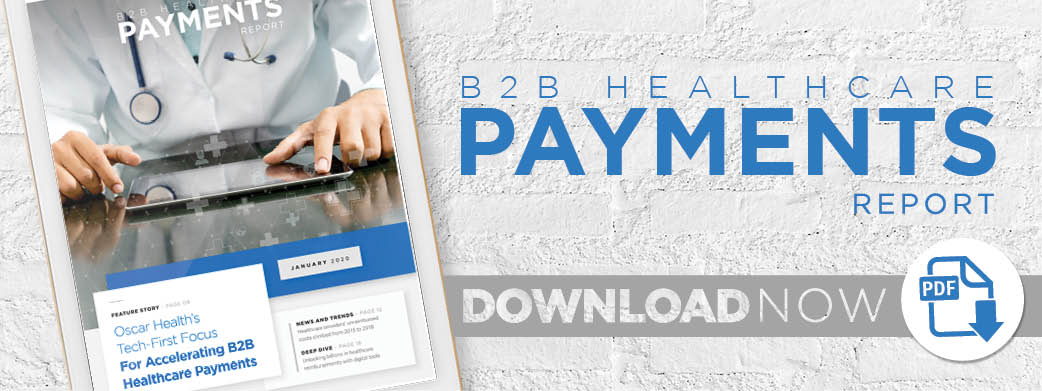Deep Dive: How Digital Updgrades Help Healthcare Providers’ Cash Flows

Healthcare providers must carefully safeguard their cash flows to operate, but many face hurdles to getting fully compensated for provided services. The American Hospital Association (AHA) told PYMNTS via email that hospitals often prefer that insurance companies pay them through the low-cost, digital Healthcare Electronic Funds Transfer standard. Hospitals otherwise may get paid via paper check or virtual cards, but AHA said the high processing charges associated with the latter make it particularly undesirable.
Many steps precede insurers’ fund disbursements, however. Reports show that healthcare providers can struggle to earn medical claim approvals. They must then decide whether to handle rejected claims by shifting bill responsibility to patients — a tricky move, given that many are too financially burdened to pay on time — or simply go unpaid for completed work. Those seeking to avoid such budgetary pains must encourage insurers to send electronic fund transfers (EFTs) as soon as possible.
One key intervention focuses on strategically filing claims to maximize approval odds, which can smooth healthcare providers’ cash flows. The B2B reimbursement process is complicated and slow, however, and confusing legacy practices only exacerbate its drawbacks. Medical staff first record patients’ diagnoses and treatments via descriptions and medical codes in their notes and later send this information to patients’ insurance companies by postal mail, electronic submissions or third-party clearing houses. Insurers review these claims and determine the share they will pay based on healthcare provider contracts, plan coverages and internal evaluations of necessity, among other factors, then deliver reimbursements or reject the claims. Denials force healthcare providers to directly bill patients, give up on compensation or adjust their documentation and resubmit, creating other frictions.
Care providers are not helpless, however, and should respond to these growing compensation frictions by modernizing their accounts receivable (AR) practices and automating and digitizing filing and management systems. The following Deep Dive examines how such upgraded claims processes could give healthcare providers faster reimbursements.
The High Costs of Claims Errors
Providers work several compensation models into their health insurance contracts, typically submitting claims to firms for full or partial remuneration. Insurers review the claims to determine which prescriptions, procedures and supplies are covered under patients’ plans and then reimburse healthcare providers for valid claims.
Alternative B2B payment structures are also being explored. Value-based care models see insurers pay hospitals based on the health of covered patient populations and the quality of services provided, rather than the specific treatments administered. One type of value-based care is bundled payments, which are handled in several ways. Insurers can pay healthcare providers in a lump sum that is then pay for all services administered and physicians. The sum may represent projected costs associated with particular medical conditions, and healthcare providers then pocket the difference if they spend below that amount and eat the costs if they go over.
Reimbursement methods in which providers submit claims for specific treatments and then wait to be compensated for the costs of each remain common, despite some appetite for exploring different models. This standard practice is not without pains, however. Misunderstandings can turn would-be approvals into denials for claims affecting services covered by patients’ insurance plans, and procedure explanations or billable item code errors are often at fault. Hospitals faced 270 billion initial denials in 2016, one report noted, and another found $262 billion worth of claims — 9 percent of the $3 trillion submitted — were initially denied that year, though 63 percent of the latter were later successfully appealed.
Upgrading Insurance Claims for the 21st Century
Healthcare providers may find disputing rejected claims and adjusting them for reappraisal to be overwhelming. Technological updates can help, and switching to electronic filing from paper can improve accuracy and efficiency. The nonprofit Council for Affordable Quality Healthcare reported in 2015 that providers spent $0.35 per electronically submitted claim — a significant savings over the average paper-based claim cost of $1.36.
Automated systems can also be trained to examine billing and coding accuracy, confirm that billed items are covered by plans and even alert remediation specialists to entries unlikely to be approved. This enables personnel to proactively tailor claims and possibly avoid lengthy denial and readjustment processes.
Numerous hurdles block healthcare providers from receiving full, speedy compensation for their work, but newer technologies could improve their chances of reimbursement and relax budgetary constraints. Claim-filing software solutions can play important roles in helping them improve their cash flows by reducing the likelihood that insurers will refuse bills, the first barrier standing in the way of insurers issuing timely digital payments. Such offerings can be powerful additions to healthcare providers’ payments technology toolkits and make revenue collection smoother.
